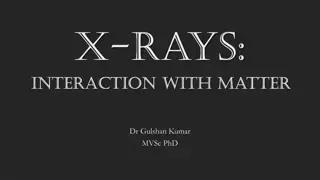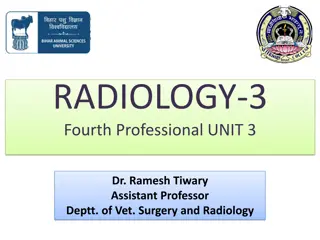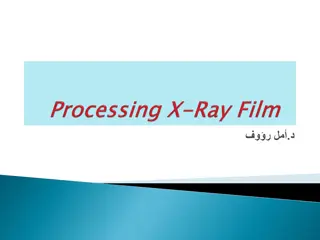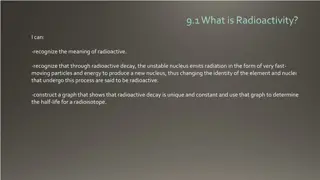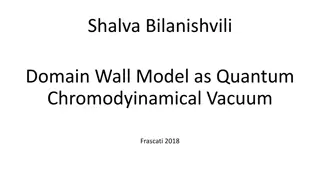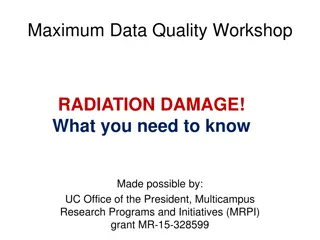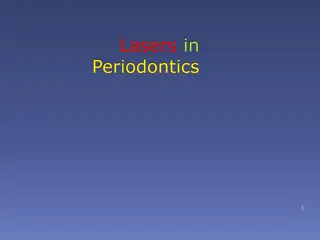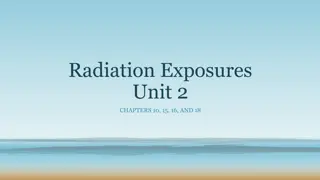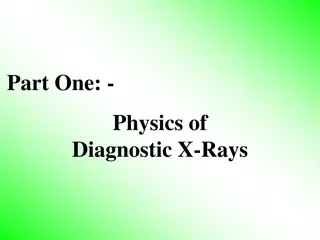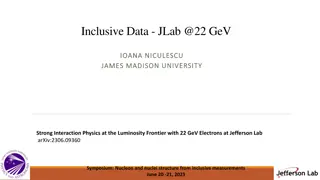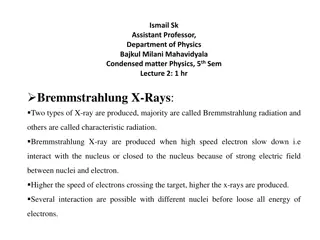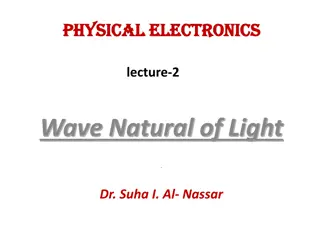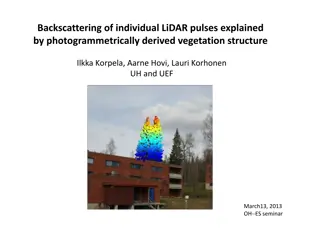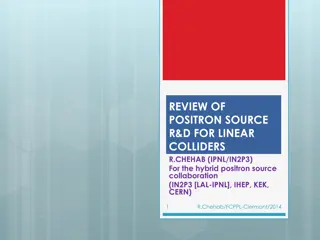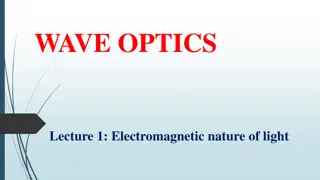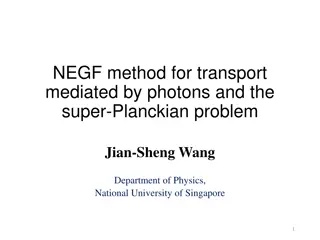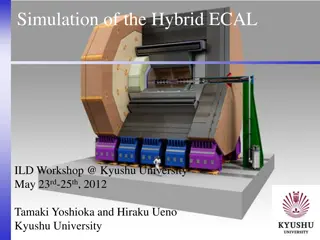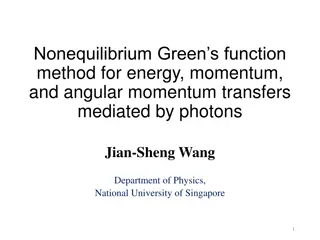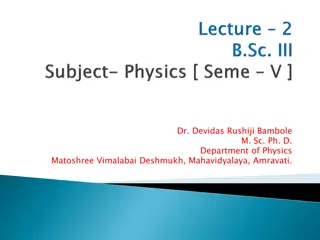Understanding the Components of an X-Ray Machine
An X-ray machine consists of vital components like the x-ray tube, power supply, cathode, and anode. The x-ray tube houses the cathode and anode, which are responsible for generating x-rays. The cathode includes a filament heated to emit electrons, while the anode has a target to convert electron en
5 views • 22 slides
Large Scale Structure Chapter 5
Simone Ferraro from Lawrence Berkeley National Laboratory discusses the significance of Cosmic Microwave Background (CMB) experiments in probing the large-scale structure of the universe. Covering topics like the interaction of photons with matter, CMB lensing, and CMB lensing tomography, this prese
3 views • 21 slides
Exploring the Composition of the Universe
The universe is a vast expanse consisting of various components. Only 0.4% comprises galaxies, while hydrogen, helium, protons, neutrons, and electrons make up 4%. The remaining 96% includes photons, neutrinos, dark matter, and dark energy. Photons, fundamental particles of light, exhibit different
0 views • 30 slides
Understanding Thermal Radiation and Stefan-Boltzmann Law
Thermal radiation is the electromagnetic radiation emitted by a body due to its temperature, propagating even in the absence of matter. The modern theory explains it as the propagation of photons with energy quantized by Planck's constant. Integrating over all wavelengths gives the Stefan-Boltzmann
0 views • 58 slides
Understanding Nd:YAG Laser and Its Applications
Nd:YAG laser is a solid-state laser system used in various applications due to its ability to generate laser light in the near-infrared region. This laser operates in a four-level system, with Nd:YAG crystal as the active medium. The construction, working principles, advantages, and applications of
1 views • 22 slides
Search for Dark Photons Utilizing Advanced Germanium Detectors at University of South Dakota
Research at the University of South Dakota under the collaboration PIRE-GEMADARC focuses on developing advanced germanium detectors with low energy thresholds for detecting low mass dark photons. The study aims to optimize event detection using new Ge detectors with internal charge amplification. Th
0 views • 16 slides
Understanding X-rays: Interaction with Matter in Diagnostic Imaging
X-rays, being photons traveling at the speed of light, interact with matter in various ways such as Coherent Scatter, Compton Scatter, Photoelectric Effect/Absorption, Pair Production, and Photodisintegration. These interactions involve exciting atoms, ionization, and energy transfer, influencing th
0 views • 9 slides
Understanding X-Ray Production and Interactions in Radiology
Explore the fundamentals of X-ray production, including the types of ionizing radiation and interactions of photons with matter. Learn about the photoelectric effect, Compton effect, and characteristics of X-ray tubes, essential for radiology professionals and students. Delve into the mechanisms beh
0 views • 17 slides
Understanding UV/Visible Spectroscopy and Electromagnetic Radiation
Spectroscopy is the study of the interaction of matter with light, specifically UV and visible radiation. Electromagnetic radiation, consisting of photons, transmits energy through space as waves with oscillating electric and magnetic fields. The relationship between wavelength and frequency is key,
0 views • 50 slides
Understanding X-Ray Film Processing Techniques
When a beam of photons exposes an X-ray film, it chemically alters the silver halide crystals, creating a latent image. Film processing involves developer, fixer, and a series of steps to convert the latent image into a visible radiographic image. The developer reduces silver ions in exposed crystal
0 views • 26 slides
Understanding Basic Electrical Concepts
Delve into the fundamentals of electricity, covering atom structure, electrical materials, direct and alternating currents, and more. Gain insights into key terms and definitions essential for basic circuit analysis. Explore the significance of atom charges, materials conductivity, and the role of p
0 views • 21 slides
Understanding Radioactivity and Nuclear Radiation
Radioactivity is the process in which unstable nuclei emit radiation, such as alpha, beta, or gamma particles, to become stable. This emission can change the element's identity and is crucial in fields like nuclear power and understanding Earth's core heat source. Different radioactive isotopes like
0 views • 12 slides
Understanding the Principle and Working of Semiconductor Lasers
Semiconductor lasers operate through absorption, spontaneous emission, and stimulated emission processes. Absorption of radiation causes electrons to jump to higher energy levels, leading to light emission. Spontaneous emission is when excited electrons return to ground state by emitting photons, wh
3 views • 17 slides
Exploring Quantum Chromodynamics and Effective Potential in Vacuum Physics
Delve into the intricacies of Quantum Chromodynamics and the concept of effective potential in the context of vacuum physics. Discover how quarks, leptons, photons, W and Z bosons, gluons, and the Higgs boson play crucial roles in shaping the fundamental structures of the quantum vacuum. Explore the
1 views • 11 slides
Evolution of Light Theory: From Wave Theory to Quantum Theory
At the turn of the century, the discovery of the photoelectric effect challenged the wave theory of light, leading to the development of the quantum theory by Max Planck and Albert Einstein. This new theory introduced the concept of discrete energy units known as quanta, bridging the gap between wav
1 views • 62 slides
Understanding Radiation Damage in Crystallography
Explore the impact of radiation damage on crystallography, focusing on dose proportional to photons per area rather than time or heat. Learn about MGy, radiation damage world records, crystal lifetime based on flux and dose, and self-calibrated damage limits. Discover insights from various studies a
0 views • 71 slides
Channeling 2014 - Summary of Hybrid Positron Source and Crystal Undulator Workshop
In Channeling 2014, a workshop was held discussing topics such as the hybrid positron source with granular converter, crystal undulator, and parametric X-ray radiation. The workshop presented the concept of a crystal radiator providing photons and an amorphous converter for positron production. Tech
0 views • 18 slides
Understanding Photodiodes: Operation, Types, and Symbols
A photodiode is a sensitive semiconductor device that converts light into electric current. Operating in reverse bias, it generates charge carriers in the depletion region using external energy sources such as light. Different types include PN junction, PIN, and avalanche photodiodes, each designed
1 views • 36 slides
Understanding Lasers in Periodontal Therapy
Laser technology in periodontal therapy harnesses the energy of photons to provide precise and effective treatment. Originally developed as MASER, the laser produces monochromatic, coherent light with unique properties such as directionality. Key components include the active medium, power supply, a
4 views • 58 slides
Understanding Lasers in Periodontics: A Comprehensive Overview
Lasers play a significant role in periodontics, offering precise treatment with minimal discomfort. The technology involves light amplification, stimulation of photons, emission processes, and properties of laser light. Classification of lasers based on active medium types is explored, along with sp
0 views • 30 slides
Unveiling Dark Matter Mysteries Through Dark Photons
Delve into the exploration of dark matter through the lens of dark photons in the galactic center and detectors. Uncover the enigmatic nature of dark matter, its interactions, existing constraints, and our model with fermionic dark matter and a dark photon mediator. Discover strategies to evade cons
0 views • 18 slides
Comparison of Hanbury Brown Twiss Effect for Bosons and Fermions
This study compares the Hanbury Brown Twiss (HB&T) effect for bosons and fermions, showcasing how different correlation functions apply to these particles in quantum systems. The analysis delves into the mathematical structures and order correlations for both bosons and fermions, illustrating the ph
0 views • 13 slides
Understanding Filtration in Radiography
Filtration is a crucial process in radiography that involves eliminating undesirable low-energy photons to enhance image quality and reduce radiation dose to patients. This process involves using filters made of materials like aluminum to selectively absorb photons. Measurement of filtration is expr
0 views • 63 slides
Exploring Dark Matter and Fundamental Particles Research Updates
This collection of images and information delves into the research activities led by Mauro Raggi and P. Valente from Sapienza Università di Roma and INFN Roma. It discusses the challenges and possibilities in parameter space coverage, potential tests required for efficient extraction from electron
0 views • 11 slides
Simulation and Reconstruction on BEPCII Polarization Measurement
Simulation and reconstruction process for BEPCII polarization measurement involve generating events, recording back-scattered photons in phase space, analyzing polarization on glass plates and Si sensors, and fitting results to optimize data accuracy.
0 views • 17 slides
Symposium on Positron Emission Tomography and Boron Neutron Capture Therapy Time-Over-Threshold Calibration in J-PET
The 3rd Symposium on Positron Emission Tomography and 1st Symposium on Boron Neutron Capture Therapy focused on Time-Over-Threshold calibration within the framework of J-PET. The event outlined experimental details, event selection, results, and key features of the Jagiellonian Positron Emission Tom
0 views • 35 slides
Photoproduction of Pionic Atoms at the Gamma Factory: Research Overview
Research conducted by V. V. Flambaum, J. Jin, and D. Budker at the Gamma Factory (GF) on photoproduction of pionic atoms is detailed in this content. It explores the formation of pionic atoms with negative pions orbiting the nucleus in a hydrogen-like system, emphasizing strong interaction effects a
0 views • 11 slides
Introduction to the Physics of Diagnostic X-Rays
The discovery of X-rays by W.C. Roentgen in 1895 was accidental, leading to a groundbreaking advancement in the field of radiology. X-ray photons are part of the electromagnetic spectrum and have applications in diagnostic radiology, radiation therapy, and nuclear medicine. The production of X-ray b
0 views • 30 slides
Exploring Strong Interaction Physics with 22 GeV Electrons at JLab
Investigate the nucleon and nuclei structure through inclusive electron scattering at 22 GeV, delving into formalisms and structure functions. Discussions on the Electron Ion Collider, nuclear PDFs, world data comparisons, and definitive proof of three-nucleon short-range correlations at Jefferson L
0 views • 21 slides
Understanding Bremmstrahlung and Characteristic X-Rays in Condensed Matter Physics
In condensed matter physics, Bremmstrahlung X-rays and characteristic X-rays are produced through different interactions of high-speed electrons with nuclei in target atoms. Bremmstrahlung radiation is generated when electrons slow down near the nucleus, while characteristic radiation is produced wh
0 views • 5 slides
Exploring Quantum Information through Polarization of Photons
Quantum information and photon polarization are explored in this detailed presentation featuring the ultimate quantum 2-state system. The content delves into the behavior of single photons at a quantum level, showcasing the intriguing properties and implications of quantum superposition in polarizat
1 views • 14 slides
Understanding the Dual Nature of Light: Wave and Particle Models
Light exhibits a dualistic nature, being describable both as a wave and a stream of particles known as photons. The wave model explains phenomena such as interference patterns, reflection, refraction, and diffraction, while the particle model clarifies how light can cause electrons to be emitted fro
0 views • 16 slides
Modern Physics Concepts in the 20th Century: Photons, Uncertainty, and Particle-Wave Duality
Modern physics in the 20th century blurred the lines between particles and waves, introducing concepts like photons, Heisenberg's uncertainty principle, and the dual nature of matter. Topics covered include the behaviors of electromagnetic waves, the photon concept, and the limitations of measuring
0 views • 23 slides
Understanding LiDAR Backscattering and Vegetation Structure Analysis
Exploring the intricacies of LiDAR pulse backscattering in relation to vegetation structure analysis using photogrammetry-derived data. Discussing the technical aspects of pulsed LiDAR sensors, hot-spot view geometry, time-stamped photons, vicarious reflectance calibration, and challenges in radiome
1 views • 19 slides
Review of Positron Source R&D for Linear Colliders by R. Chehab
Intense positron sources, whether polarized or not, are vital for future e+e- linear colliders. This review covers different types of e+ sources, including circularly polarized photons and methods to obtain polarized positrons. Techniques such as helical magnetic undulators and Compton backscatterin
0 views • 26 slides
Understanding the Electromagnetic Nature of Light in Wave Optics
Exploring the electromagnetic properties of light, this lecture covers the dual nature of light as both a wave and particles, the quantized particle nature of light known as photons, and the manifestation of the electromagnetic nature of light through Maxwell's equations. It delves into wavefronts,
0 views • 8 slides
Advanced Methods in Transport Phenomena and Quantum Field Theory
Explore cutting-edge research in transport processes mediated by photons, tight-binding models for electron behavior, electron-field interactions, NEGF definitions, fluctuation-dissipation theorem, Dyson equations, and Keldysh equations in the context of quantum field theory and super-Planckian near
0 views • 18 slides
Simulation of the Hybrid ECAL Workshop at Kyushu University 2012
Hybrid ECAL, a solution combining Silicon and Scintillator-strip layers, was studied at the workshop held at Kyushu University in May 2012. The configuration, parameters, calibration, and performance evaluation of the Hybrid ECAL were discussed. The study focused on achieving a cost-effective ECAL w
0 views • 10 slides
Advances in Nonequilibrium Green's Function Method for Energy Transfer Mediated by Photons
Research discusses the application of the Nonequilibrium Green's Function method for analyzing energy, momentum, and angular momentum transfers mediated by photons. Various topics covered include near-field heat transfer, Coulomb interactions, electron-photon transitions, local equilibrium assumptio
0 views • 37 slides
Understanding the Photoelectric Effect and Einstein's Equation
The photoelectric effect is explained by Einstein through assumptions of photons and their interaction with electrons on a metal surface. The maximum kinetic energy of ejected electrons depends on the frequency of incident radiation, as shown in Einstein's Equation. The greater the frequency, the hi
0 views • 6 slides






